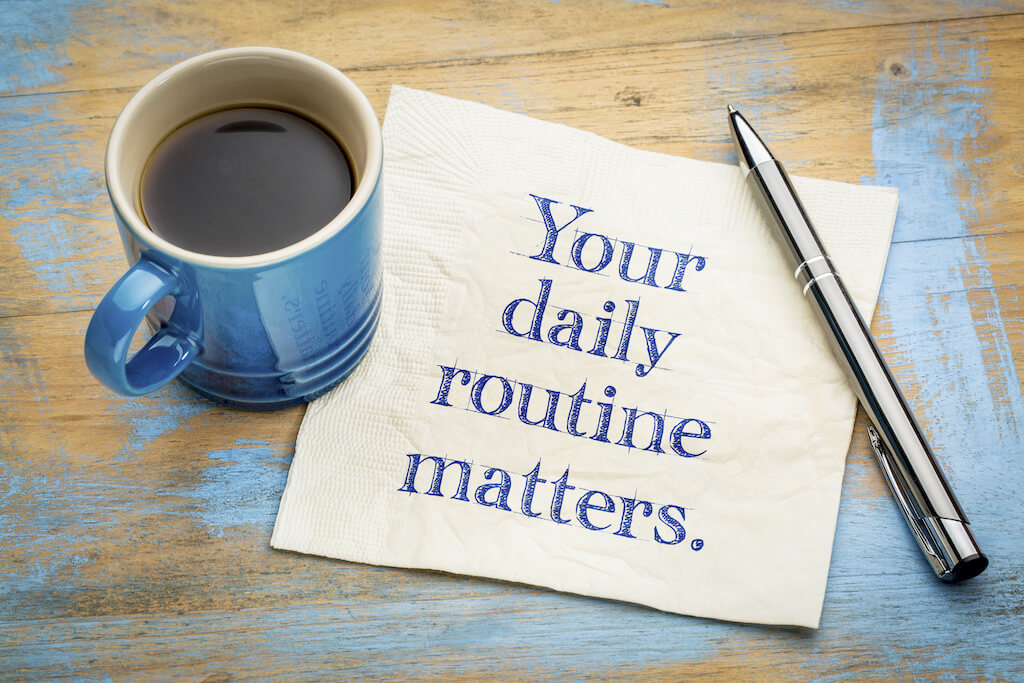The Resistance
In the beginning, I resisted routine. A routine meant I was locked in, locked into this role and locked into the responsibility. It signified the loss of spontaneity, the loss of control over how I spent my time, the loss of freedom. I felt that once I acquiesced to the routine, I was accepting full accountability and the tether would tighten. So, I resisted.
“The human spirit lives on creativity and dies in conformity and routine.” Vilayat Inayat Khan
My resistance resulted in being in constant reaction mode, feeling out of control and ultimately losing time. I first started to see the value in routine when I realized how poorly I was eating. As I was bouncing from doctor’s appointment to doctor’s appointment and one task to another, I missed meals and then in a fit of desperation, ate whatever was most convenient. I slowed the slide down the slippery slope of fast food drive throughs and convenience stores by making a list of every protein snack that I could keep on hand and grab on the go, leave in the car or combine for a meal.
“Just keep in mind: the more we value things outside our control, the less control we have.” Epictetus
The Realization
By adhering to a nutrition routine, I regained my power. My mood, mind and body were back within my control. I wondered what else I could better manage with a routine. What else kept me in reaction mode? I decided that Dad’s medications, his preference for dirty dishes and his meals were candidates for increased order. Dad also resisted a routine, apple-tree, and he resisted my involvement in his daily activities. Our dance was a tug of war.
“By far the best way to prevent a tug-of-war is to not pick up your end of the rope.” Don Lancaster, Incredible Secret Money Making Machine
The routine I set in place was stealth and covered all of the bases in one swift, sweep through his area. I checked his meds and painting supplies, swapped his cup, glasses and silverware and grabbed the dirty clothes. In the evening I set his dinner on his coffee table, told him it was there and what it was. Each of these mini tasks had caused countless moments of contention when attended to randomly throughout the day. Challenging me on the details allowed Dad to maintain control over the very few things left within his control. The morning and evening routine took the drama out of the day and out of our interactions.
The Reinforcement
I had to learn when to collaborate and involve Dad in care decisions and which decision making opportunities frustrated him. He did not want to participate in meal planning, but he did want to eat at 5 PM sharp. He wanted to take his morning and evening medications without prompting. We evolved through many iterations of facilitating his independence. For example, when the pre-packed pill container became too challenging, we put his pills in plastic 1 oz containers, like the little cups for salad dressing at a restaurant, and set it on his coffee table morning and evening. We checked back to see that they were taken and that there were no pills on the table or floor.
All was working well until there was a blip in the breakthrough. A mini crisis hit and instead of doubling down on the routine, I decided it didn’t fit into the new normal. Dad had several teeth fall out due to contraband gum, and it was an ordeal. Dentist visits. He insisted that he glue a recovered tooth back in place. He got a partial and refused to take it out. Finally, in the chair for bridge prep, Dad changed his mind. More drama. Back home, Dad made calls to countless dentists to price implants and discuss other options. We finally landed back on the bridge. It was weeks of contentious interactions. If I had regrouped and modified the routines, it would have helped me manage the turmoil much more effectively. Instead, I fell back into old habits of unhealthy eating, poorly monitoring Dad’s meds and mismanaging his meals.
The Result
Finally, I learned to modify the routine to keep the core components in place and it has helped me get through more turbulent times. One modification has been to have my husband take over when I am occupied with new challenges. He added pieces that helped him maintain the routine; He uses a timer, a checklist and a system to help him more easily manage the meds. Another modification involved breaking one routine into several small ones and piecing them together in different orders based on circumstances. Looking at the week ahead, I identify routine disrupters and plan accordingly.
When I am proactive and keep to the routines, I am better able to prioritize, I am acting rather than reacting and at the end of the day, I have more time. In effect, I free up my mind and time for creativity. Routines have helped me construct a sustainable caregiving experience. Dad is starting to show early signs of dementia which means that routines will play an even greater part in our lives going forward. I am grateful for having learned the value now.
Navigating the Caregiver River: A Journey to Sustainable Caregiving is available on Amazon. Also, check out the Self-Caregiving Strategies Podcast.
Schedule Theresa Wilbanks to speak on caregiving and empower the caregivers in your workplace or community with the 12 Sustainable Caregiving Strategies.
Advice offered is for general information only; please contact your healthcare team, legal or financial advisors to guide your particular situation.


Pingback: Self-Care During COVID-19: Lessons from Family Caregivers - Sustainable Caregiving™
Pingback: How Do We Sustain Our Ability to Provide Care? - Sustainable Caregiving™